New center to coordinate work to mitigate effect of satellite constellations on astronomyby Jeff Foust — February 5, 2022 [SN]
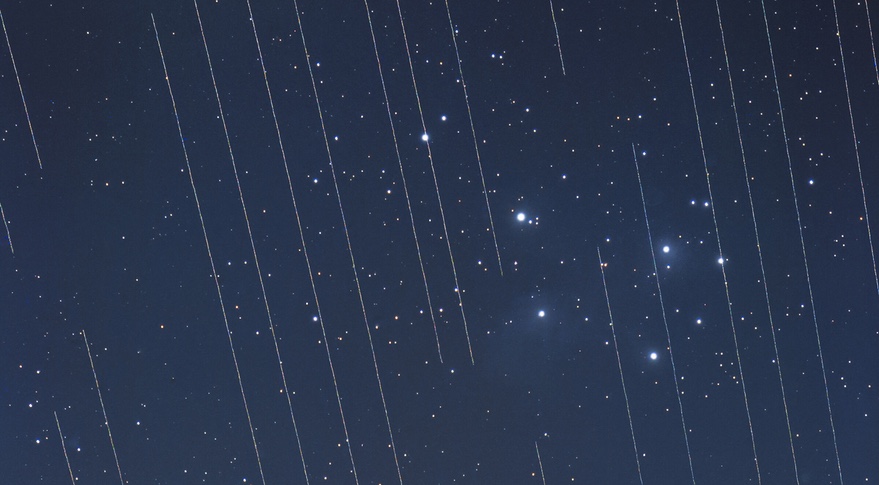 Streaks from satellites cross the Pleiades on a long-duration exposure, illustration the interference the growing number of satellites can have on astronomy. Credit: T. Hansen/IAU OAE/CC
Streaks from satellites cross the Pleiades on a long-duration exposure, illustration the interference the growing number of satellites can have on astronomy. Credit: T. Hansen/IAU OAE/CCWASHINGTON — The International Astronomical Union (IAU) is establishing a center to help astronomers deal with the adverse effects of satellite constellations.
The IAU said Feb. 3 it selected a proposal jointly submitted by the National Optical-Infrared Astronomy Research Laboratory, or NOIRLab, run by the National Science Foundation, and the Square Kilometer Array Observatory (SKAO) to operate its Centre for the Protection of the Dark and Quiet Sky from Satellite Constellation Interference. The center will formally start operations April 1.
The center will bring together astronomers and other experts on various efforts to address the visible and radio interference caused by constellations like OneWeb and SpaceX’s Starlink. That work will include the development of software tools for astronomers, work on national and international policies, community outreach and work with industry on relevant technologies.
https://spacenews.com/new-center-to-coordinate-work-to-mitigate-effect-of-satellite-constellations-on-astronomy/Connecting the Dots | Getting satellite regulation up to speedby Jason Rainbow — January 27, 2022
The rapidly evolving space industry is fast outpacing regulatory regimes, which did not anticipate unprecedented demand for building businesses in non-geostationary orbit (NGSO).
Roughly 17,000 satellites will launch to mainly NGSO between 2021 and 2030, according to the latest research from analysts at Euroconsult, compared with around 3,800 spacecraft across all orbits over the previous decade.
https://spacenews.com/connecting-the-dots-getting-satellite-regulation-up-to-speed/Wyler raises $50 million for “sustainable” megaconstellationby Jason Rainbow — February 7, 2022 [SN]
 "We are designing our systems to not only prevent space debris generation, but to eventually actively reduce space debris so generations to come will be able to access the power of space," says E-Space founder Greg Wyler. Credit: Keith Johnson for SpaceNews
"We are designing our systems to not only prevent space debris generation, but to eventually actively reduce space debris so generations to come will be able to access the power of space," says E-Space founder Greg Wyler. Credit: Keith Johnson for SpaceNewsTAMPA, Fla. — E-Space, the Greg Wyler-led startup behind Rwanda’s September filing for a constellation of 300,000 satellites, said Feb. 7 it has raised $50 million to fund the launch of two sets of test satellites this year.
While E-Space’s “Beta 1” launch is planned for March and serial satellite production is slated for 2023, the company’s Feb. 7 news release provided no details about the upcoming mission.
https://spacenews.com/wyler-raises-50-million-for-sustainable-megaconstellation/Shanghai signs agreement with China’s megaconstellation group, aims to foster commercial space hubby Andrew Jones — February 17, 2022 [SN]
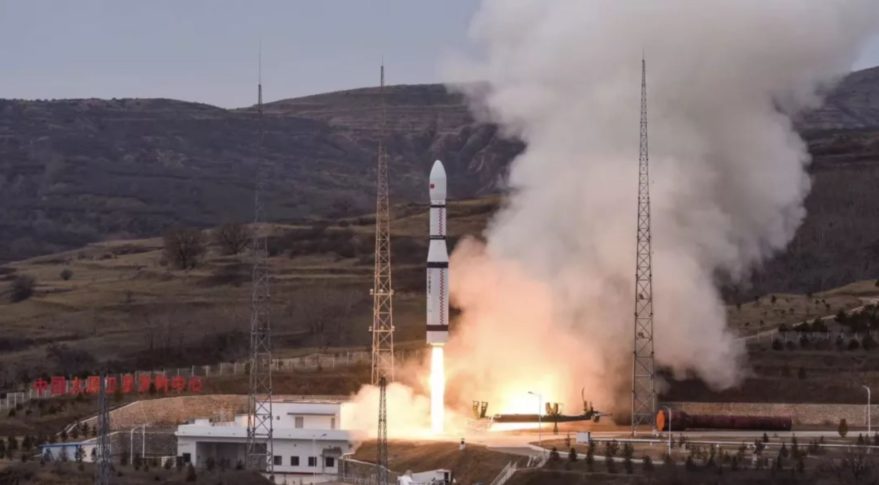 Liftoff of a Long March 6, developed by the Shanghai Academy of Spaceflight Technology, from Taiyuan in 2019. Credit: SAST
Liftoff of a Long March 6, developed by the Shanghai Academy of Spaceflight Technology, from Taiyuan in 2019. Credit: SASTHELSINKI — Shanghai local government entered an agreement with the state company responsible for China’s planned broadband megaconstellation Wednesday, while also aiming to foster a space hub to support reusable rockets and satellite mass production.
Shanghai Party Secretary Li Qiang met with Zhang Dongchen, chairperson of China Satellite Network Group, and Yang Baohua, the group’s general manager, for the signing ceremony of the strategic cooperation framework agreement in the city Feb. 16.
https://spacenews.com/shanghai-signs-agreement-with-chinas-megaconstellation-group-aims-to-foster-commercial-space-hub/Amazon signs multibillion-dollar Project Kuiper launch contractsby Jeff Foust — April 5, 2022 [SN]
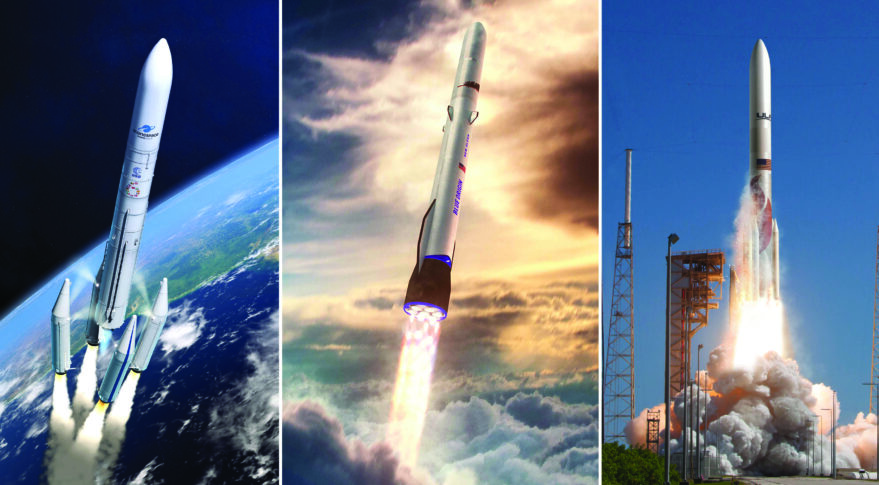 Amazon’s 83-launch deal includes 18 Ariane 6 launches, 12 to 27 New Glenn launches and 38 United Launch Alliance Vulcan Centaur. Credit: Arianespace/Blue Origin/ULA
Amazon’s 83-launch deal includes 18 Ariane 6 launches, 12 to 27 New Glenn launches and 38 United Launch Alliance Vulcan Centaur. Credit: Arianespace/Blue Origin/ULACOLORADO SPRINGS — In the largest commercial launch deal ever, Amazon is purchasing up to 83 launches from Arianespace, Blue Origin and United Launch Alliance to deploy most of its 3,236-satellite Project Kuiper broadband megaconstellation, contracts worth several billion dollars.
Amazon announced April 5 the agreements to launch an unspecified number of satellites on Ariane 6, New Glenn and Vulcan Centaur rockets over five years. The launches are in addition to nine Atlas 5 launches it purchased from ULA a year ago. Amazon did not disclose financial terms but said it is spending billions of dollars on these contracts as part of the constellation’s $10 billion overall cost.
https://spacenews.com/amazon-signs-multibillion-dollar-project-kuiper-launch-contracts/Amazon launch contracts drive changes to launch vehicle productionby Jeff Foust — April 5, 2022 [SN]
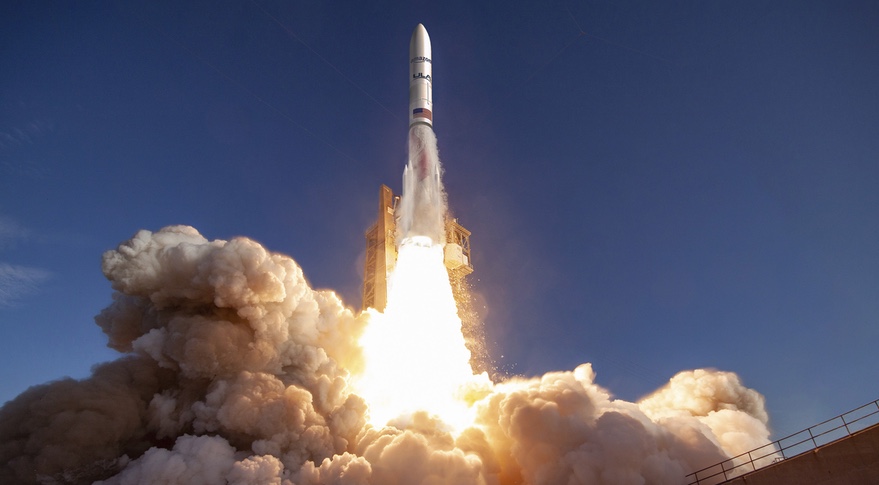 United Launch Alliance and its suppliers are investing in new production capacity and infrastructure to support ULA's launch contract with Amazon for Project Kuiper satellites. Credit: ULA
United Launch Alliance and its suppliers are investing in new production capacity and infrastructure to support ULA's launch contract with Amazon for Project Kuiper satellites. Credit: ULACOLORADO SPRINGS — United Launch Alliance is planning major production improvements for its Vulcan rocket while Arianespace will increase the performance of its Ariane 6 to meet the demands of their new Amazon contracts for Project Kuiper.
At a briefing during the 37th Space Symposium April 5 about Amazon’s contracts for up to 83 launches to place the bulk of its 3,236-satellite constellation into orbit, executives of launch providers said the size of the deal prompted changes in their vehicles and production facilities.
https://spacenews.com/amazon-launch-contracts-drive-changes-to-launch-vehicle-production/Amazon hails progress in driving down Project Kuiper antenna costsby Jason Rainbow — April 5, 2022 [SN]
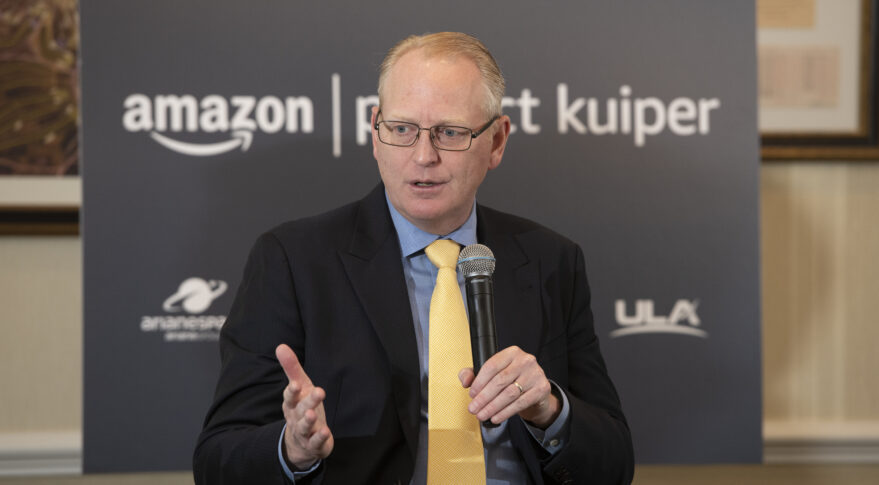 Dave Limp, senior vice president for Amazon Devices and Services, addresses attendees during the 37th Space Symposium in Colorado Springs. Credit: Tom Cooper/Getty Images for Amazon
Dave Limp, senior vice president for Amazon Devices and Services, addresses attendees during the 37th Space Symposium in Colorado Springs. Credit: Tom Cooper/Getty Images for AmazonCOLORADO SPRINGS — An Amazon executive said the cost to produce antennas for its proposed Project Kuiper megaconstellation is already “well under $500,” even as SpaceX retreats from the subsidized $499 price it charges customers for its operational Starlink terminals.
“I actually think we can go lower, but when you get under $500 you can then start penciling out a business model that scales broadly, globally,” Dave Limp, senior vice president for Amazon Devices and Services, said during the 37th Space Symposium April 5 here.
https://spacenews.com/amazon-hails-progress-in-driving-down-project-kuiper-antenna-costs/Amazon books up to 83 launches with ULA, Arianespace, and Blue OriginApril 5, 2022 Stephen Clark [SFN]
 Artist’s illustrations of Blue Origin’s New Glenn, ULA’s Vulcan Centaur, and the European Ariane 6 rocket. Credit: Blue Origin / United Launch Alliance / ESA / Spaceflight Now
Artist’s illustrations of Blue Origin’s New Glenn, ULA’s Vulcan Centaur, and the European Ariane 6 rocket. Credit: Blue Origin / United Launch Alliance / ESA / Spaceflight NowAmazon announced the largest commercial launch deal in history Tuesday, revealing agreements for up to 83 missions to deploy thousands of internet satellites on United Launch Alliance’s Vulcan Centaur rocket, Arianespace’s Ariane 6, and Blue Origin’s New Glenn vehicle.
The agreements solidify the commercial business cases for all three rockets, more than doubling the backlogs for Vulcan Centaur, Ariane 6, and New Glenn rockets before any of them have ever flown.
https://spaceflightnow.com/2022/04/05/amazon-books-up-to-83-launches-with-ula-arianespace-and-blue-origin/Connecting the Dots | Diverging NGSO distribution strategiesby Jason Rainbow — April 11, 2022 [SN]
After revolutionizing the launch industry through vertical integration, SpaceX hopes to do the same for satellite broadband with its Starlink megaconstellation.
Starlink’s go-it-alone approach contrasts with OneWeb and others planning non-geostationary orbit (NGSO) services through a network of distributors.
https://spacenews.com/connecting-the-dots-diverging-ngso-distribution-strategies/Telesat to order 100 fewer satellites for LEO constellationby Jason Rainbow — May 6, 2022 [SN]
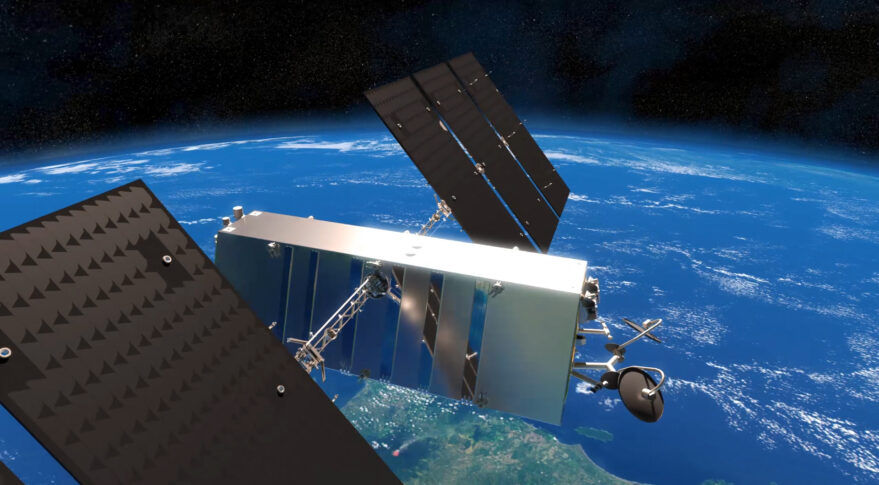 Telesat selected Thales Alenia Space to be the prime manufacturer of its global LEO constellation Lightspeed. Credit: Telesat
Telesat selected Thales Alenia Space to be the prime manufacturer of its global LEO constellation Lightspeed. Credit: TelesatTAMPA, Fla. — Increasing costs and delays have forced Telesat to downsize plans for 298 low Earth orbit satellites by a third to keep within its $5 billion budget.
The Canadian satellite operator plans to order just 188 satellites plus 10 in-orbit spares from Thales Alenia Space, Telesat CEO Dan Goldberg said during the company’s May 6 earnings call.
https://spacenews.com/telesat-to-order-90-fewer-satellites-for-leo-constellation/Starlink and OneWeb reach spectrum coordination planby Jason Rainbow — June 14, 2022 [SN]
 SpaceX and OneWeb told the FCC they have settled their spectrum interference differences. Credit: FCC via Flickr
SpaceX and OneWeb told the FCC they have settled their spectrum interference differences. Credit: FCC via FlickrTAMPA, Fla. — SpaceX and OneWeb said June 13 they have reached a spectrum coordination plan that would enable their current and second-generation broadband megaconstellations to coexist.
In a letter to the Federal Communications Commission, the companies asked the regulator to disregard any spectrum coordination issues they had previously filed against each other.
https://spacenews.com/starlink-and-oneweb-reach-spectrum-coordination-plan/